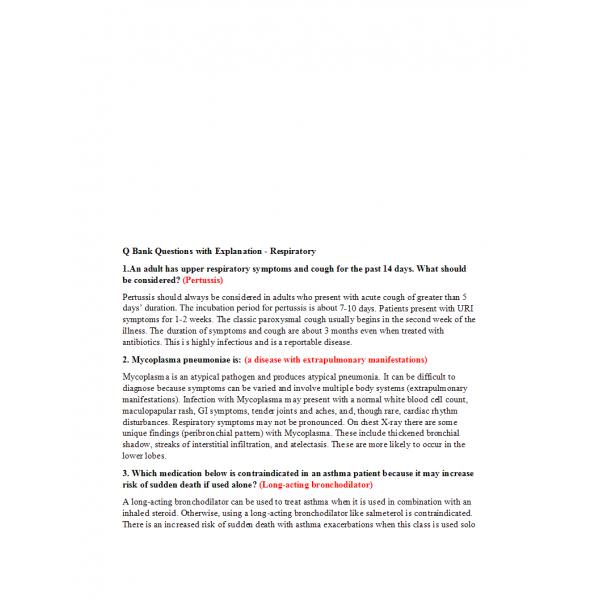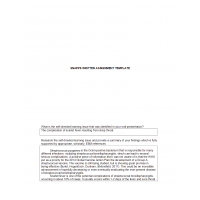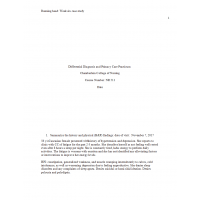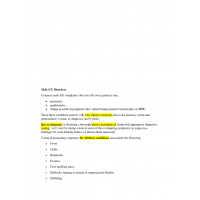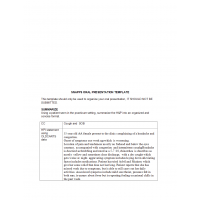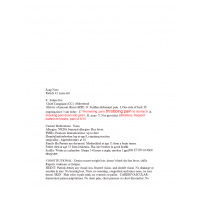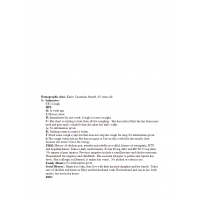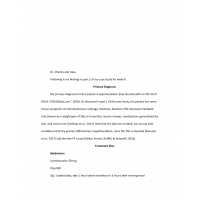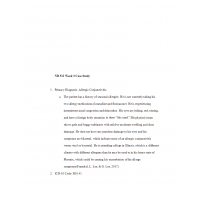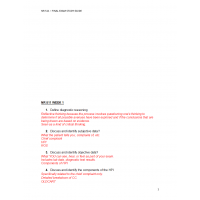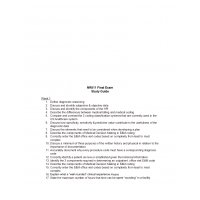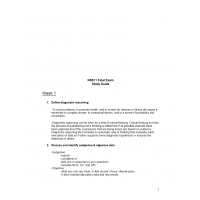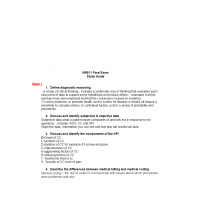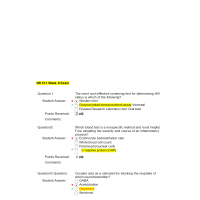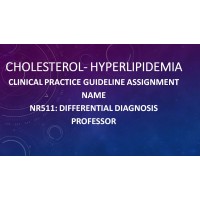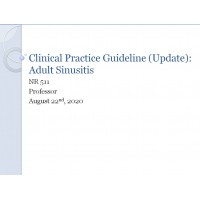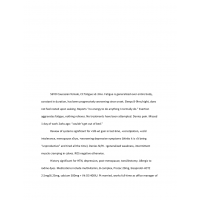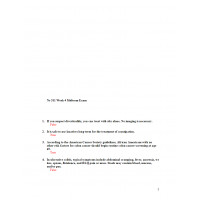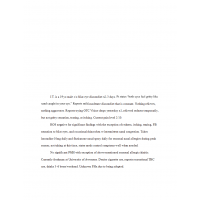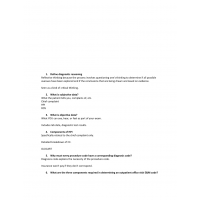Q bank Questions - Respiratory
1. An adult has upper respiratory symptoms and cough for the past 14 days. What should be considered?
2. Mycoplasma pneumoniae is:
3. Which medication below is contraindicated in an asthma patient because it may increase risk of sudden death if used alone?
4. A 75-year-old female with emphysema who has been treated with inhaled steroids for many years should:
5. A patient received the pneumonia immunization at age 60 years. He is 65 years old and presents to your clinic today. What recommendation should be made about the pneumococcal immunization?
6. Which of the following medications should be used cautiously in a patient who has asthma? 7. The most common symptom associated with acute bronchitis is:
8. Mild persistent asthma is characterized by:
9. The chest circumference of a 12 month-old is:
10. A patient with cough and fever is found to have infiltrates on chest x-ray. What is his likely diagnosis?
11. An uncommon symptom associated with acute bronchitis is:
12. Patients who have cough-variant asthma:
13. The most common cause of atypical pneumonia in adults is:
14. Which patient might be expected to have the worst FEV1?
15. A patient who has asthma presents with chest tightness, wheezing, coughing, and fever. He has wheezing and diminished breath sounds in the upper right lobe. His cough is nonproductive, and he denies nasal symptoms. Which symptom is not likely related to his asthma?
16. Ipratropium is very widely used in the treatment of COPD. Which of the following statements about ipratropium is correct?
17. An 80-year-old has Stage 3 COPD. He is most likely to have concomitant:
18. A 6-year-old child who has moderate persistent asthma is diagnosed with pneumonia after chest X-ray and laboratory studies. He developed a sudden onset of fever with chills. He is in no distress. What is the preferred treatment for him?
19. What disease is usually managed with a short-acting or long-acting inhaled anticholinergic medication?
20. A patient with pneumonia reports that he has rust-colored sputum. What pathogen should the nurse practitioner suspect?
21. A 44-year-old nonsmoker is diagnosed with pneumonia. He is otherwise healthy and does not need hospitalization at this time. Which antibiotic can be used for empirical treatment of pneumonia according to the most recent Infectious Diseases Society of America/American Thoracic Society guidelines?
22. The gold standard for diagnosing pneumonia on chest X-ray is the presence of:
23. An 83-year-old healthy adult is diagnosed with pneumonia. He is febrile but in no distress. What is the preferred treatment for him?
24. The pneumococcal immunization in infants has:
25. A 78-year-old adult who has a 50 pack year smoking habit asks the nurse practitioner about the benefits of quitting “at my age.” What should the nurse practitioner reply?
26. M. pneumoniae and C. pneumoniae are respiratory pathogens that:
27. An 18-month-old child is diagnosed with bronchiolitis. His respiratory rate is 28 breaths per minute. Which choice below is most appropriate for patient management?
28. How should a 20-year-old college age student who presents with cough, night sweats, and weight loss be screened for TB?
29. An example of a short-acting beta agonist is:
30. A patient with asthma uses one puff twice daily of fluticasone and has an albuterol inhaler for PRN use. He requests a refill on his albuterol inhaler. His last prescription was filled 5 weeks ago. What action by the NP is appropriate?
31. Patients with asthma:
32. A 26-year-old being treated for community-acquired pneumonia (CAP) has been taking azithromycin (standard dose) in therapeutic doses for 72 hours. His temperature has gone from 102° F to 101° F. What should be done?
33. A 60-year-old patient newly diagnosed with COPD presents to your office. He would like to get the influenza immunization. He has no evidence of having had the pneumococcal immunization. What statement is correct?
34. Which of the following is NOT part of the differential for a patient who complains of cough?
35. A 65-year-old has been diagnosed with asthma. Older patients who have newly diagnosed asthma:
36. A 67-year-old patient with COPD presents an immunization record that reflects having last received the pneumococcal immunization (PPSV23) when he was 60 years old. Which statement below reflects the current standard of practice recommended by CDC for this patient?
37. A 24-year-old college student who does not smoke is diagnosed with pneumonia. He is otherwise healthy and does not need hospitalization at this time. What antibiotic represents the best choice for treatment for him?
38. What does a peak flow meter measure?
39. The major laboratory abnormality noted in patients who have pneumococcal pneumonia is:
40. Which drug class is never used to treat chronic obstructive pulmonary disease (COPD)?
41. A patient who has asthma presents with chest tightness, wheezing, coughing, and fever. He has wheezing and diminished breath sounds in the upper right lobe. His cough is non-productive, and he denies nasal symptoms. Which symptom is most likely related to pneumonia?
42. A patient with COPD has been using albuterol with good relief for shortness of breath. He is using it 3-4 times daily over the past 4 weeks. How should the NP manage this?
43. Which of the following may be used to diagnose COPD?
44. A patient with acute bronchitis was diagnosed at an urgent care center 10 days ago. He reports that he received an antitussive for nighttime cough, a steroid injection and oral steroids, and an antibiotic. Which of these interventions was of greatest benefit in resolution of his symptoms?
45. A 65-year-old patient has COPD. She receives a prescription for an albuterol inhaler. What medication information should be provided to this patient?
46. A patient presents with symptoms of influenza during influenza season. He has not received the immunization against influenza. What should be used to help diagnose influenza in him?
47. The most common cause of pneumonia in people of all ages is:
48. A patient recently received levofloxacin for 7 days to treat pneumonia. His respiratory symptoms have resolved, but today he calls the office. He reports having severe watery diarrhea, abdominal cramping, and low-grade fever. What should be done?
49. A 20-year-old college age student has a positive TB skin test. Which choice listed below provides definitive diagnosis of tuberculosis?
50. A patient has cough, pharyngitis, nasal discharge, and fever. He has been diagnosed with acute bronchitis. Which symptom is least likely in the first 3 days of this illness?
51. Which of the following characteristics is always present in a patient with COPD?
52. “Good control” of asthma is measured by the number of times weekly a patient uses a rescue inhaler. What choice below indicates “good control”?
53. Mr. Smith has smoked for 45 years. Which of the following medications may worsen one of his diseases?
54. The most common sequela of influenza in older adults is:
55. A healthy 7-year-old child is diagnosed with atypical pneumonia. He is febrile but not in distress. What is the preferred treatment for him?
56. A 30-year-old patient with intermittent asthma is using his “rescue” medication once daily. How should this be managed? He should receive a prescription for a(n):
57. Which choice below most appropriately differentiates acute bronchitis from pneumonia in a patient who has a productive cough?
58. The most common cause of pneumonia in an otherwise healthy 3-year-old child is:
59. Which medication below should be avoided in a patient with stage 3 COPD?
60. A patient with acute bronchitis and cough for 5 days calls to report that his cough is productive of discolored sputum. He has no other new symptoms. How should the nurse practitioner manage this?
61. A patient has received a prescription for lisinopril. Which side effect most commonly occurs with this medication?
62. A 24-year-old presents with fever, rhinorrhea, and paroxysmal, high-pitched cough. This is:
63. A 60-year-old patient reports chronic cough and sputum production. He has a long history of exposure to secondhand cigarette smoke from his wife. What diagnosis is most likely?
64. A patient is diagnosed with asthma. Which question is most important to ask when deciding on medication management?
65. Breath sounds auscultated over the periphery of the lung fields are quiet and wispy during the inspiratory phase followed by a short, almost silent expiratory phase. These breath sounds are considered:
66. The two tests that can indicate current infection with hepatitis B are:
67. A mother of a 4-week-old infant visits your office. She states that her baby is vomiting after feeding and then cries as if he is hungry again. What should the nurse practitioner assess?
68. A patient has the following laboratory value. (anti-HAV IgG: positive). What is the clinical interpretation?
69. The early signs and symptoms of appendicitis in an adult:
70. A 70-year-old presents to the nurse practitioner’s office for a well exam today. What medication probably has no effect on screening for occult blood in the stool?
71. Symptoms of uncomplicated reflux disease in older adults should be treated:
72. Which symptom is INCONSISTENT with irritable bowel syndrome in older adults?
73. A 20-year-old female patient presents with tenderness at McBurney’s point. Appendicitis is considered. What laboratory test should be done initially to determine the etiology of this patient’s abdominal pain?
74. A patient with a suspected inguinal hernia should be examined:
75. A healthcare provider (“the HCP”) was stuck with a needle from a patient suspected to be infected with HIV (“the patient”). A rapid HIV test was performed on the patient and found to be positive. This means that:
76. A patient has had right upper quadrant pain that has lasted for the past 3 days, but the pain has become acute in the past 12 hours. He has low-grade fever. Which lab test(s) will be elevated if he has pancreatitis?
77. A patient presents with complaints of bright red stools over the past week. This symptom could be consistent with:
78. A 24-year-old female presents with pain and tenderness in the right lower abdominal quadrant. Her pelvic exam and urinalysis are within normal limits. Her WBC is elevated and her urine pregnancy test is negative. What is part of the differential diagnosis?
79. What medication used to treat patients who have GERD provides the fastest relief of heartburn symptoms?
80. A patient with gall bladder disease has classic symptoms. Which symptom below is NOT classic of gallbladder disease?
81. Most patients who have acute hepatitis B infection:
82. A patient has been diagnosed with hepatitis A. The most common reported risk factor is:
83. A 6-week-old male infant is brought to the nurse practitioner because of vomiting. The mother describes vomiting after feeding and feeling a “knot” in his abdomen especially after he vomits. The child appears adequately nourished. What is the likely etiology?
84. Which of the following is NOT a risk factor for developing hepatitis B?
85. An 83-year-old patient is diagnosed with diverticulitis. The most common complaint is:
86. Which medication listed below can exacerbate the symptoms of GERD?
87. Choose the number on the image that most closely approximates the location of a direct inguinal hernia.
88. A 70-year-old patient states that he had some bright red blood on the toilet tissue this morning after a bowel movement. He denies pain. What is the LEAST likely cause in this patient?
89. GERD (gastroesophageal reflux disease) and physiologic reflux have similar characteristics. However, physiologic reflux
90. A 56-year-old male patient has been diagnosed with an inguinal hernia. What symptom would make the nurse practitioner suspect an incarcerated hernia?
91. A 48-year-old patient has the following laboratory values. (anti-HCV: reactive, HCV RNA: detectable). How should they be interpreted?
92. Choose the number on the image that most closely approximates the location of an indirect inguinal hernia?
93. A patient presents with right upper quadrant and upper abdominal pain. Acute cholecystitis is suspected because the pain radiates to the:
94. A 63-year-old male has been your patient for several years. He is a former smoker who takes simvastatin, ramipril, and an aspirin daily. His blood pressure and lipids are well controlled. He presents to your clinic with complaints of fatigue and “just not feeling well” for the last few days. His vital signs and exam are normal, but his liver enzymes are elevated. His hepatitis panel is negative for infectious hepatitis. What is the most likely cause of his elevated liver enzymes?
95. What is the simplest screen for nutritional adequacy in elderly patients?
96. A 31-year-old patient is suspected of having hepatitis C. He reports possible exposure about a month ago. (anti-HCV: nonreactive, HCV RNA: not detectable).How should the nurse practitioner interpret his laboratory results?
97. A patient has been diagnosed with viral gastroenteritis. He has nausea and vomiting, and has started having lower abdominal cramps. What is the most effective intervention for him?
98. A 35-year-old patient has the following laboratory values. How should they be interpreted? (HBsAG: negative, Anti-HBc: negative, Anti-HBs: negative)
99. An 85-year-old adult has chronic constipation. How should this be managed initially?
100. Which is NOT an effective strategy for helping older adults gain weight?
101. The relationship between duodenal ulcer disease and H. pylori infection is:
102. A 37-year-old has routine blood work performed during an annual exam. On exam he has a tender, enlarged liver. How should the nurse practitioner proceed?
103. A 19-year-old female presents with lower abdominal pain that began about 12 hours ago. She denies vaginal discharge. Which choice below is the least likely cause of her symptoms?
104. The most common place for indirect inguinal hernias to develop is:
105. A 14 year-old male patient has an acute, painless groin swelling. Which tool would yield the most information to identify the etiology of the swelling?
106. Mrs. Lovely, an 84-year-old, complains of fecal incontinence. A likely cause is:
107. A 40-year-old patient has the following laboratory values. How should they be interpreted? HBsAG: negative, anti-HBs: positive, anti-HBc: negative
108. A patient has the following lab values. This indicates that he: (HBsAG: negative, anti-HBc: negative, anti-HBs: positive)
109. A 3-day-old full-term infant has a bilirubin level of 16 mg/dL. How should this be managed?
110. Which imaging study of the abdomen would be LEAST helpful in diagnosing an acute appendicitis?
111. A patient has the following laboratory values. What does this mean? (anti-HAV IgM: negative, anti-IgG: negative)
112. The most common cause of diarrhea in adults is:
113. An 84-year-old presents with a stated involuntary weight loss. He states that he’s lost about 6 pounds in the last 6 or 8 weeks. What statement below is NOT part of the assessment
114. What choice below is most commonly associated with pancreatitis?
115. Most patients who have acute hepatitis A infection:
116. A 95-year-old male has lost muscle mass as he has aged. He does not have any underlying disease that has caused this loss. What is this termed?
117. A patient has the following lab results: (anti-HCV: reactive) This means:
118. What medication may be used to treat GERD if a patient has tried over-the-counter ranitidine without benefit
119. Which set of symptoms is most likely in a patient infected with C. difficile?
120. Older adults frequently complain of constipation. Which medication listed below does NOT increase the likelihood of constipation in an older adult?
121. A 40-year-old patient has the following laboratory values. How should they be interpreted? (HBsAG: negative, anti-HBc-positive, anti-HBs: positive)
122. A patient has suspected peptic ulcer disease. Her symptoms occur a few hours after eating. She probably has a:
123. A patient has received a prescriptions for metronidazole for treatment of C. difficile. What should be avoided in this patient?
124. A 5-year-old has been diagnosed with pinworms. He lives with his mother. There are no other members of the household. How should his mother be managed?
125. Which of the following symptoms is typical of GERD?
126. An 82-year-old adult has constipation. A supplement known to cause constipation is:
127. An inguinal hernia is palpated on a male patient by an examiner. Which word below best describes what the hernia feels like when touched by the examiner?
128. Hirschsprung’s disease is characterized by:
129. Many older adults have cachexia. What characterizes this?
130. What medication listed below could be used to increase appetite in an anorexic patient?
131. A patient has been diagnosed with hepatitis B. The most common reported risk factor is:
132. Which of the following is an appropriate initial intervention for gastroesophageal reflux disease (GERD) in an 8-week-old?
133. A 42-year-old patient was diagnosed with ulcerative colitis many years ago. What part of his routine health screenings should be stressed by the nurse practitioner?
134. A 20-year-old female patient presents with tenderness at McBurney’s point. What laboratory test supports a diagnosis of appendicitis?
135. A patient has elevated liver enzymes. What is the likely etiology of the elevation?
136. An 83-year-old patient is diagnosed with diverticulitis. Where is her pain typically located?
137. The initial step in the management of encopresis is:
138. A 45-year-old patient has the following laboratory values. (HBsAG-positive, anti-HBc: positive, anti-HBs: negative) How should they be interpreted?
139. A patient has hepatitis B. He probably has a predominance of
140. A 43-year-old female patient reports a possible exposure to hepatitis C about 4 months ago. Which statement is true about this patient? (HBsAG: negative, anti-HBc: negative, anti-HBs: positive, anti-HCV: nonreactive, HCV RNA: not detectable)
141. A 5-year-old female’s playmate has been diagnosed with pinworms. The mother brings her child in for an exam. The 5 year-old denies rectal itching. How should the NP proceed?
142. A 24-year-old male has recently returned from a weekend camping trip with friends. He has ulcerative colitis and history of migraine headaches. He reports a 2-day history of headache, nausea, and vomiting with weakness. Which of the following is not part of the differential diagnosis?
143. A mother presents with her 1-month-old infant. She reports that he cries inconsolably every evening after his first evening feeding. She asks for help. What should be done?
144. A 50-year-old with a history of consumption of 3-4 alcoholic drinks daily and weekend binges has elevated liver enzymes. Which set of enzymes is most representative of this patient?
145. A 26-year-old female presents with concerns about possible hepatitis C (HCV) infection. She admits to IV drug use 2 months ago and sharing needles with several other people. Initial laboratory studies have been completed. How should this be managed? (anti HCV: reactive)
146. An older adult has suspected vitamin B12 deficiency. Which of the following lab indices is more indicative of a vitamin B12 deficiency?
146. Which term does not characterize hemorrhoids
147. Which description is more typical of a patient with acute cholecystitis?
148. Which patient has the least worrisome symptoms associated with his diarrhea? One with:
149. A 26-year-old female complains of pain at McBurney’s point. She feels nauseated. Her vital signs are provided. The most appropriate initial action by the NP is to:
150. A 7-year-old male presents with encopresis. The NP might expect:
151. A 79-year-old with an appendicitis is unlikely to exhibit:
152. An 85-year-old adult has chronic constipation. What is the most likely cause of her constipation?
153. A patient with diarrhea is tested for C. difficile. How soon should the enzyme immunoassay (EIA) yield results?
154. What is true regarding older adults who are overweight?
155. The relationship between colon polyps and colon cancer is that polyps:
156. An older patient presents with left lower quadrant pain. If diverticulitis is suspected, how should the NP proceed?
157. A patient is in the clinic with a 36-hour history of diarrhea and moderate dehydration. Interventions should include:
158. Children with an inguinal hernia:
159. A 10-year-old female presents with a 3-month history of abdominal pain. She has been diagnosed with recurrent abdominal pain. During the interview the nurse practitioner is likely to elicit a finding of:
160. A patient has the following laboratory values. (HBsAG: positive, IgM anti-HBc: positive) What does this mean?
161. A patient asks for advice about a medication that will produce rapid relief if he is having heartburn symptoms. What should the nurse practitioner recommend?
162. Which of the following would be usual in a patient with biliary colic?
163. A fecal occult blood test (FOBT) obtained during a rectal examination:
164. A patient has a positive hepatitis B surface antibody. This means he:
165. The most common reason that older adults develop peptic ulcer disease is:
166. A 15-year-old is about 10% below her ideal body weight. Laboratory studies were performed. Which complaint might be common in this patient?
167. The three most common causes of bacterial diarrhea in the US are Salmonella, Campylobacter, and:
168. Which choice contains three medications that should have liver function tests measured prior to initiation of the medications?
169. The most common symptoms associated with gastroesophageal reflux disease (GERD) are heartburn and:
170. A patient has two palpable, tender, left preauricular nodes that are about 0.5 cm in diameter. What condition might this be associated with?
171. A 3-year-old has fluid in the middle ear that does not appear infected. The eardrum appears normal. This is referred to as:
172. A contact lens wearer presents with an erythematous right conjunctiva. He denies blurred vision. There is scant drainage and crusting around the right eyelashes. He reports that crusting was present when he woke up this morning. How should the exam begin?
173. A 2-month-old is diagnosed with thrush. An exam of this patient’s saliva demonstrates all except:
174. A 6-month-old infant has a disconjugate gaze. The nurse practitioner observes that the 6-month-old tilts his head when looking at objects in the room. Which statement is true?
175. A patient presents to your clinic with a painless red eye. Her vision is normal, but her sclera has a blood red area. What is this termed?
176. A nurse practitioner performs a fundoscopic exam. He identifies small areas of dull, yellowish-white coloration in the retina. What might these be?
177. At what age would it be unusual to see thrush?
178. Epstein-Barr virus is responsible for:
179. A patient has been diagnosed with mononucleosis. Which statement is correct?
180. A 32-year-old patient is a newly diagnosed diabetic. She has developed a sinus infection. Her symptoms have persisted for 10 days. Six weeks ago, she was treated with amoxicillin for an upper respiratory infection. It cleared without incident. What should be recommended today?
181. An NP examines a screaming 2-year-old. A common finding is:
182. An infant is brought to the nurse practitioner because his gaze is asymmetrical. Which finding indicates a need for referral to ophthalmology?
183. Which statement about serous otitis media is correct?
183. Which of the following symptoms is more indicative of a bacterial sinusitis than viral?
184. A patient stated that his ears felt stopped up. He pinched his nose and blew through it forcefully. The nurse practitioner diagnosed a ruptured left tympanic membrane. What would indicate this?
185. Arcus senilis is described as:
186. A patient reports a penicillin allergy. What question regarding the allergy should the nurse practitioner ask to determine whether a cephalosporin can be safely prescribed?
187. A 61-year-old male presents with a 12-hour history of an extremely painful left red eye. The patient complains of blurred vision, haloes around lights, and vomiting. It began yesterday evening. On examination, the eye is red, tender and inflamed. The cornea is hazy and pupil reacts poorly to light. The most likely diagnosis in this patient is:
188. A patient presents with severe toothache. She reports sensitivity to heat and cold. There is visible pus around the painful area. What is this termed?
189. A patient who is 65 years old states that she has “hay fever” and has had this since childhood. What agent could be safely used to help with rhinitis, sneezing, pruritis, and congestion?
190. A common complaint in older patients who have cataracts is:
191. A 20-year-old-patient presents with complaints of a sore throat and cough that began this morning. His oral temperature is 101.2 °F. He has the following laboratory results. What is his most likely diagnosis?
192. Swimmer’s ear is diagnosed in a patient who has right-sided tragal tenderness. What other symptom might he have?
193. A patient who presents with a complaint of sudden decreased visual acuity has a pupil that is about 4 mm, fixed. The affected eye is red. What might be the etiology
194. On routine exam, a 15-year-old patient’s tympanic membrane (TM) reveals a tiny white oblong mark just inferior to the umbo on the surface of the TM. The patient has no complaints of ear pain and gross hearing is intact. What is this?
195. A patient with mononucleosis would most likely have:
196. A patient with a bacterial sinusitis cannot spread this to others via:
197. A patient with allergic rhinitis developed a sinus infection 10 days ago. He takes fexofenadine daily. What should be done with the fexofenadine?
198. The nurse practitioner performs a fundoscopic exam on a patient who has recently been diagnosed with hypertension. What is the significance of AV nicking?
199. Which long-acting antihistamine listed below is sedating?
200. The hearing loss associated with aging involves:
201. A patient with diarrhea has a positive enzyme immunoassay for C. difficile. He is on clindamycin for a tooth abscess. How should he be managed?
202. A patient has a penicillin allergy. He describes an anaphylactic reaction. Which medication class should be specifically avoided in him?
203. A 12-year-old complains of itching in his right ear and pain when the pinna is pulled or the tragus is pushed. Examination revealed slight redness in the ear canal with a clear odorless fluid. This could be suggestive of:
204. A 3-year-old has been recently treated for an upper respiratory infection (URI) but drainage from the right nostril persists. What should the NP suspect?
205. What medication should always be avoided in patients with mononucleosis?
206. At what age should oral health risk assessment begin?
207. A 45-year-old patient describes a spinning sensation that has occurred intermittently for the past 24 hours. It is precipitated by position changes like rolling over in bed. During these episodes, he complains of intense nausea. Which choice best describes benign paroxysmal positional vertigo?
208. Which of the following will decrease the risk of acute otitis media in a 6-month-old?
209. Acute otitis media can be diagnosed by identifying which otic characteristic(s)?
210. A 58-year-old farmer presents with a wedge-shaped, pinkish, clear growth on the nasal side of his eye. He states that it has been present for a while, but only recently began to feel as if a foreign body was in his eye. This is probably a:
211. A 4-year-old child with otitis media with effusion:
212. A patient diagnosed with Strep throat received a prescription for azithromycin. She has not improved in 48 hours. What course of action is acceptable?
213. A 70-year-old presents urgently to the nurse practitioner clinic with angioedema. This began less than an hour ago. He is breathing without difficulty. What medication may have caused this?
214. A 70-year-old patient has begun to have hearing loss. She relates that her elderly parents had difficulty hearing. Which complaint below is typical of presbycusis?
215. A 6-day-old has bilateral mucopurulent eye discharge. Which historical finding explains the etiology of the discharge?
216. Group A Strep pharyngitis:
217. A 14-year-old was diagnosed and treated for left acute otitis media 4 weeks ago. She presents today for a follow-up visit. There is an effusion in the left ear. She denies complaints. How should this be managed?
218. The patient presents with complaints of morning eyelash crusting and itchy red eyes. It began on the left and now has become bilateral. Based on the most likely diagnosis, what should the nurse practitioner tell the caregivers about this condition?
219. A patient presents with tragal pain. What is the most likely diagnosis?
220. A medication considered first line for a patient with allergic rhinitis is a:
221. A 17-year-old has a complaint of ear pain. If he has otitis externa, which complaint is most likely?
222. Which of the following is most likely observed in a patient with allergic rhinitis?
223. What is the usual age for vision screening in young children?
224. In a patient with mononucleosis, which laboratory abnormality is most common?
225. A 2-year-old has a sudden onset of high fever while at daycare. The daycare attendant describes a seizure in the child. The child is brought to the clinic; neurologically he appears normal. His body temperature is 99.9° F after receiving ibuprofen. He is diagnosed with otitis media. How should the nurse practitioner manage this?
226. A tympanic membrane (TM) is erythematous. Which factor listed below is NOT the cause of an erythematous TM?
227. An 80-year-old is having difficulty hearing. When the nurse practitioner examines him, she is unable to visualize the tympanic membrane because of cerumen impaction. This produces what kind of hearing loss?
228. A 4-month-old infant has thrush. The mother is breastfeeding. She reports that her nipples have become red, irritated, and sensitive. What should the nurse practitioner advise the mother of this baby to treat thrush?
229. An older adult has cerumen impaction in both ears. His hearing is diminished. This type of hearing loss is:
230. What symptom tetrad is most commonly associated with infectious mononucleosis?
231. A patient presents to clinic with a complaint of a red eye. Which assessment below rules out the most worrisome diagnoses?
232. A rapid strep test was negative was negative in a 12-year-old female with tonsillar exudate, fever, and sore throat. Which statement is true regarding this?
233. A patient with environmental allergies presents to your clinic. She takes an oral antihistamine every 24 hours. What is the most effective single maintenance medication for allergic rhinitis?
234. A patient has nasal septal erosion with minor, continuous bleeding. There is macerated tissue. What is a likely etiology?
235. A patient has been taking amoxicillin for 8 days for sore throat. Today, the patient has developed a pruritic full body rash and is diagnosed with penicillin allergy. What describes the skin manifestations of penicillin allergy?
236. A patient has been diagnosed with acute rhinosinusitis. Symptoms began 3 days ago. Based on the most likely etiology, how should this patient be managed?
237. An otherwise healthy 6-year-old male has been diagnosed with otitis media. His mother reports that he has not had an ear infection since he was 3 years old. How long should he be treated with an antibiotic?
238. The single most effective maintenance therapy for allergic rhinitis is:
239. A 30-year-old male has been diagnosed with nonallergic rhinitis. Which finding is more likely in nonallergic rhinitis than allergic rhinitis?
240. A 70-year-old female states that she sees objects better by looking at them with her peripheral vision. She is examined and found to have a loss of central vision, normal peripheral vision, and a normal lens. This best characterizes:
241. In a patient who is diagnosed with mastoiditis, which of the following is most likely?
242. A 70-year-old patient in good health has a large, white plaque on the oral mucosa of the inner cheek. There is no pain associated with this. What is a likely diagnosis?
242. A 39-year-old has a sudden onset of a painful right red eye. He reports sensitivity to light and the sensation of a foreign body, though his history for a foreign body is negative. He does not wear contact lenses. How should the NP manage this?
243. How should the class effect of the nasal steroids be described?
244. The most common complication of influenza is:
245. An older adult has a common cold. She calls your office to ask for advice for an agent to help her runny nose and congestion. What agent is safe to use?
246. A 4-year-old was diagnosed and treated for acute otitis media in the left ear 4 weeks ago. She is here today for a well-child visit. There is an effusion in the left ear. She denies complaints. How should this be managed?
247. When does a child’s vision approximate 20/20?
248. A patient is diagnosed with thrush. What might be found on microscopic exam?
249. A 3-year-old has been diagnosed with acute otitis media. She is penicillin allergic (Type 1 hypersensitivity reaction). How should she be managed?
250. On examination of the tympanic membrane (TM), a cloudy, red, bulging ear drum with impaired mobility is detected. This is consistent with:
251. A patient with mononucleosis has pharyngitis, fever, and lymphadenopathy. His symptoms started 3 days ago. What is a likely finding in this patient?
252. A patient presents to a nurse practitioner clinic with paroxysmal sneezing, clear rhinorrhea, nasal congestion, and facial pain. Which symptom below is NOT associated with allergic rhinitis?
253. What clinical finding necessitates an urgent referral of the patient to an emergency department?
254. When examining vessels of the eye, the:
255. A patient describes a sensation that "there is a lump in his throat." He denies throat pain. On exam of the throat and neck, there are no abnormalities identified. What is the most likely reason this occurs?
256. A patient who is otherwise healthy states that he woke up this morning and has been unable to hear out of his left ear. The Weber and Rinne tests were performed. What is the primary reason for doing this?
257. What are the most common signs and symptoms associated with mononucleosis?
258. A 93-year-old demented adult has been recently treated for an upper respiratory infection (URI) but drainage from the right nostril persists. What should the NP suspect?
259. AV nicking may be identified in a patient who has what disease?
260. Most commonly, epistaxis occurs:
261. A patient presents with findings of pain, warmth, redness, and swelling below the inner canthus toward nose. Tearing is present and when pressure is applied to the lacrimal sac, a purulent discharge from the puncta is noted. This is suggestive of:
262. Which antihistamine is preferred for treating allergic rhinitis in an adolescent or adult?
263. A 70 year-old male has a yellowish, triangular nodule near the iris. This is probably:
264. A patient who is 52 years old presents to your clinic for an exam. You notice a yellowish plaque on her upper eyelid. It is painless. What should the NP assess?
265. An elderly patient who has a red eye with tearing was diagnosed with conjunctivitis. What characteristics below most closely indicate viral conjunctivitis?
266. The most common cause of acute pharyngitis in children is
267. Papilledema is noted in a patient with a headache. What is the importance of papilledema in this patient?
268. A patient is diagnosed with otitis externa. He complains of tragal pain, otic discharge, otic itching, and fever. What is the cardinal symptom of otitis externa?
269. Mr. O has been diagnosed with hearing loss secondary to exposure to an ototoxic medication. Which one may be associated with ototoxicity?
270. A teenager with fever and pharyngitis has a negative rapid strep test. After 24 hours, the throat culture reveals “normal flora." Which conclusion can be made?
271. A microscopic examination of the sample taken from a skin lesion indicates hyphae. What type of infection might this indicate?
272. A child with a sandpaper-textured rash probably has:
273. A 40-year-old female patient presents to the clinic with multiple, painful reddened nodules on the anterior surface of both legs. She is concerned. These are probably associated with her history of:
&l| Institution & Term/Date | |
| Term/Date | Chamberlain University |
NR 511 Midterm Exam Question Bank with Answers - Respiratory
- Product Code: 2021
- Availability: In Stock
-
$45.00
Related Products
NR 511 Week 8 Reflection
$10.00
NR 511 Week 4 Midterm Exam
$25.00
NR 511 Week 8 Final Exam 2
$40.00
NR 511 Week 8 Final Exam 1
$35.00
NR 511 Week 2 Study Guide
$12.00

